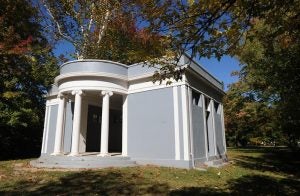Burnham House

Nathan Burnham House. Source: aadl.org.
Built in 1837, this Greek revival house is noteworthy not only for its architecture but also for its intriguing history. For over 160 years, the home built by Nathan Burnham, was located near the Huron River, although its address did change from 947 Wall Street to 940 Maiden Lane in 1969. Then in 1995, the University of Michigan wanted to build additional parking on Wall Street for the medical center across the street and purchased the Burnham lot. Sadly, at that point, most of the historic homes on the street had already been razed and the Burnham house had only been listed one year before (Covitt 2001: 30). The University had a history purchasing historic homes and then demolishing them regardless if they were historically listed and culturally significant (Covett ibid.) and for that reason it was likely to be torn down. However, after petitioning by several Ann Arbor preservationists it was removed from its foundation, transported to the Arboretum, and saved from demolition! Currently, it is an educational center for urban environmentalism.
Here’s the curious bit. Oddly, it now sits on land that is leased from the Forest Hills Cemetery. So, it is also privately owned, even though the building itself and much of the surrounding land is the University of Michigan’s. Additionally, the house’s age (the building was never previously affiliated with the University) actually makes it older than the President’s House, and thus the oldest University building.
[map id=”65″]













